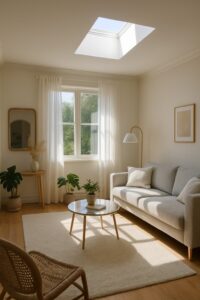
Some rooms just never seem to get enough light. Maybe it’s a basement, a hallway with no windows, or even a bedroom that faces the wrong direction. No matter how many lamps are plugged in, the space still feels dim and closed off. The good news is, there are a few smart tricks that can actually help brighten up those darker rooms—and you don’t need to knock down any walls to do it.
Don’t Block the Natural Light You Already Have
The first thing to check is whether anything is stopping the sunlight that’s already there. Sometimes heavy curtains, dark furniture, or even indoor plants can get in the way. Moving or changing these things might instantly make a room feel brighter.
Window coverings are a big one. Thick blackout curtains can make sense for sleep, but they shut out light during the day. Replacing them with light or sheer curtains helps let sunlight through while still keeping privacy. If there’s furniture in front of a window, shifting it to another spot might also help open things up.
Mirrors Make a Big Difference
One trick that works almost anywhere is using mirrors. They don’t create light on their own, but they do reflect the light already in the room. Hanging a mirror across from a window, or even near a lamp, can help bounce brightness around and make the space feel bigger and lighter.
The size of the mirror matters too. Bigger mirrors reflect more, but even smaller ones can help. Glossy surfaces like glass tables, shiny floors, or metallic decorations work in a similar way.
Skylights Are a Game-Changer
If the room doesn’t get much natural light from the sides, sometimes the answer is to go up. Skylights are windows built into the roof that let sunlight come in from above. They’re especially useful in places where regular windows aren’t an option, like hallways, upstairs bathrooms, or rooms in the middle of a house.
Some people think skylights are too expensive or hard to install, but that really depends on the type you choose and the layout of your home. To get a better idea of what you might spend, check out a breakdown of skylights cost to see how much goes into the product itself and the installation. It’s a good way to understand your options without guessing.
There are fixed skylights that only let in light, and there are vented ones that open to let in fresh air. Some even open by remote control or close automatically when it rains. They don’t just brighten a room—they can also help with airflow and make the space feel less stuffy.
Choose Lighter Colors for Walls and Decor
Dark colors on the walls or floors can make a room feel smaller and dimmer, especially if the space already doesn’t get much light. Painting the walls a light color—like white, cream, or a soft gray—can make a huge difference.
The same idea works for floors, rugs, furniture, and decorations. Swapping out dark fabrics or heavy materials for lighter shades and simpler textures can really help. Even changing a dark-colored lampshade to a white or light one can make the light spread more evenly.
Clean the Windows—Seriously
It sounds too simple, but dirty windows can block a lot of natural light. Dust, water spots, or dirt buildup on the glass can stop the sunlight from getting in, especially if the window faces the sun for part of the day.
Washing windows inside and out can let more light through without needing to change anything else. And while cleaning, it’s also a good time to trim any bushes or tree branches outside that might be blocking the view.
Use Glass or Open Furniture
Heavy, bulky furniture can soak up light and make a room feel more closed off. Using pieces that are made of glass or have open designs—like metal shelves or low-profile chairs—helps light move through the room more easily.
Even switching to a coffee table with a glass top or using a bookcase with space between the shelves can make a small space feel more open. It’s not about removing everything—just choosing things that don’t take up visual space.
Add Extra Light the Right Way
Natural light is the best kind, but sometimes it just isn’t enough—especially at night. That’s where layered lighting comes in. Using more than one light source helps even things out. Instead of one big light in the center of the ceiling, try adding lamps in different corners or under shelves.
Using bulbs that give off a warm white or daylight color can also help mimic sunlight. Some light bulbs are even made to feel more natural and reduce that cold, fake look that comes from old-style bulbs.
Let Light Travel from Room to Room
If one room gets a lot of light but the one next to it doesn’t, letting that light pass through can help both spaces feel more connected. Doors with glass panels, open archways, or even small cutouts in the wall (like indoor windows) let light move from one space to another.
This doesn’t mean taking down walls completely. Even small openings or using see-through materials can make a big difference in how bright things feel.
Think About What’s Outside
What’s going on outside the window matters too. If there’s a patio umbrella, a big tree, or even a large outdoor object blocking the sun, it might be keeping the room darker than it should be. Clearing away or adjusting those things can allow more light to get through.
Even things like adding a light-colored window awning or painting an outside wall a brighter color can reflect sunlight inside.
Bright Rooms Feel Better
Brightening up a dark room can totally change the way it feels. More light makes a space feel cleaner, more open, and just better to be in. Whether it’s by moving a few things around, switching up colors, or adding something like a skylight, there are plenty of ways to do it without needing to redo the whole house.
Just start small—clean a window, move a curtain, or hang a mirror—and go from there. Sometimes even one change is enough to make a room feel new again.







